Bandung
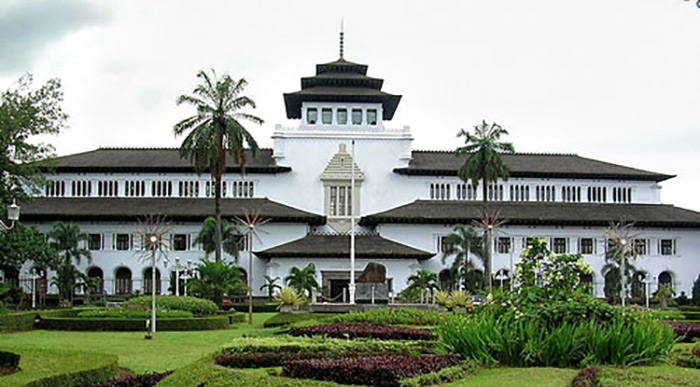 Bandung is the capital of West Java in Indonesia. Bandung is 180
kilometers southeast from Jakarta. Although it has a population of over
two million the pace of city life is slower than Jakarta's. Today
Bandung has a population of 2 million people, Bandung area an estimated 4
million. Bandung is situated on a plateau 768 meters above sea level
with a cool climate throughout the year. Bandung is the most European
city of Java. The raining season starts in Bandung a little bit earlier,
then the rest of Indonesia. Normally the raining season in Indonesia is
from October till May, the peak of the raining season is in January.
The dry season is from June until August, temperature is then 25-30
degrees Celsius during the day. In the morning, the sun is almost
shining every day, but in the afternoon many times it gets cloudy, for
sunbathing we have to wake up early from 6.30 the sun is already there.
In the evening when the sun is down the temperature has drops. The
average temperature in Bandung is 22 degrees Celsius; the weather is
pleasant all year round.
Bandung is the capital of West Java in Indonesia. Bandung is 180
kilometers southeast from Jakarta. Although it has a population of over
two million the pace of city life is slower than Jakarta's. Today
Bandung has a population of 2 million people, Bandung area an estimated 4
million. Bandung is situated on a plateau 768 meters above sea level
with a cool climate throughout the year. Bandung is the most European
city of Java. The raining season starts in Bandung a little bit earlier,
then the rest of Indonesia. Normally the raining season in Indonesia is
from October till May, the peak of the raining season is in January.
The dry season is from June until August, temperature is then 25-30
degrees Celsius during the day. In the morning, the sun is almost
shining every day, but in the afternoon many times it gets cloudy, for
sunbathing we have to wake up early from 6.30 the sun is already there.
In the evening when the sun is down the temperature has drops. The
average temperature in Bandung is 22 degrees Celsius; the weather is
pleasant all year round.There are short drives up to the mountain resorts of Lembang and the Bosscha Observatory, and higher to the volcanic crater of Tangkuban Perahu, the only crater in Java accessible all the way by car as far as its rim. It is an awe-inspiring sight of emanating sulfur fumes. Descent into all the volcano's 12 craters is only possible with the aid of an experienced guide, because of the presence of suffocating gases at certain spots. Just a 15 minutes drive from Tangkuban Perahu is a hot springs resort. Here we can swim in warm mineral water pools, good for healing skin problems. The resort provides visitors with a bar, restaurants, tennis courts and cottage style hotels overlooking a beautiful mountain-scope.
In Bandung, try to see the "Wayang Golek" wooden puppet show and hear the "Angklung" bamboo orchestra, as well as the classical Sundanese gamelan and dances. Several institutes of higher education are located here, including the country's prestigious Bandung Institute of Technology.
HISTORY
In 1488, the area now named Bandung was the capital of the Kingdom of Pajajaran. During colonial times, the government of the Dutch East Indies built a supply road connecting Batavia (now Jakarta), Bogor, Cianjur, Bandung, Sumedang and Cirebon. This event was very important for the growth of Bandung. In the 1930s the Dutch East Indies government planned for Bandung to become the capital of the Dutch East Indies due to its location, however World War II disrupted these plans.It is not known exactly when Bandung city was built. However, contrary to the beliefs of some the city was not originally built by the orders of Daendels, the Dutch East Indies Governor General, but by the orders of 'Bupati' R.A. Wiranatakusumah II. The Dutch colonial powers built wide tree-lined boulevards, villas, gardens, and fountains, earning Bandung the nickname of "Parijs van Java", the Paris of Java, in the early 20th century. Many of these structures survive to today, and can be seen along the road leading to the Dago area north of the city.
After Indonesian independence, Bandung was named as the provincial capital of West Java. Bandung was the site of the Bandung Conference which met April 18-April 24, 1955 with the aim of promoting economic and cultural cooperation among the African and Asian countries, and to counter the threat of colonialism or neocolonialism by the United States, the Soviet Union, or other imperialistic nations.
Bogor
 A bit further away from Bandung about 4,5 hours drive is Bogor,
also called the city of rain. Previously known as "Buitenzorg" (Sans
soucis or Without worries), during the Dutch colonial era, Bogor
actually lies closer to Jakarta (50 km) than it does to Bandung (120
km). Appropriately named by the Dutch as a town "without worries", they
chose Bogor to be the site for constructing the first palace of the
Dutch Governor General way back in 1745. Later restored in 1832, the
palace still stands solid and elegant today with its stretched out
gardens where deer roam freely on the green grass under majestically
tall old trees.
A bit further away from Bandung about 4,5 hours drive is Bogor,
also called the city of rain. Previously known as "Buitenzorg" (Sans
soucis or Without worries), during the Dutch colonial era, Bogor
actually lies closer to Jakarta (50 km) than it does to Bandung (120
km). Appropriately named by the Dutch as a town "without worries", they
chose Bogor to be the site for constructing the first palace of the
Dutch Governor General way back in 1745. Later restored in 1832, the
palace still stands solid and elegant today with its stretched out
gardens where deer roam freely on the green grass under majestically
tall old trees.The inhabitants of Bogor work in agriculture, forestry, industry, as civil are Christians, Catholics, Hindus and Buddhists. From a historical point of view, the Bogor Regency still has a close relationship with the history of the Pakuan Padjajaran Kingdom, which was built between the 13th - 15th centuries. This is supported by some historical objects in the form of inscriptions as old manuscript written by some historians, which were found in the area.
Bogor, is famous with its botanical garden. This botanical garden and in the garden is the palace "Buitenzorg" On a not so busy day on the road a visit to Bogor and Taman Safari can be done on the same day. The world-famous Bogor Botanical Garden borders the Palace Grounds, covering an area of 87 hectares with thousands of species of plant life from all over the world. There are over 15,000 species of trees and plants, 400 varieties of palms alone. The orchid houses contain over 3000 orchid varieties. We don't have to be a horticulturalist to enjoy the gardens, it is a masterpiece of design and a wonderful place to just stroll and enjoy the company of family and friends. See the original "Havea Brazilliensis" rubber tree, formerly imported from Brazil, and world's largest flower, the Rafflesia, a foul smelling and stem less as well as leafless plant. When visiting this Garden, arrange for a permit to visit the neighboring Presidential Palace, which belonged to the Dutch Governor General before Indonesia's independence. Doing this may be a daylong visit by leaving Jakarta in the morning and spend the night in Puncak mountainous region on the way to Bandung the next day. Here again, the whole car trip will be memorable, as scenic tropical beauty all around is really astonishing. We will also pass by another smaller Presidential Palace at Cipanas, the setting of which is in a colorful and flowery vast garden around this wooden but stylish palace.
Pelabuhan Ratu Beach
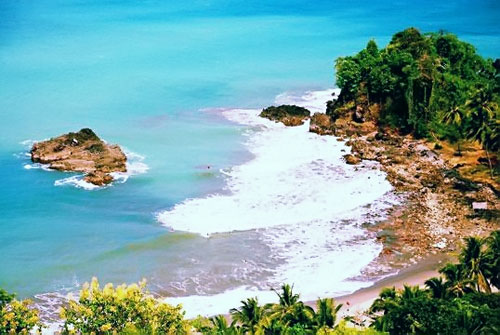 Pelabuhan Ratu is a lovely holiday resort, visited by
holidaymakers from Jakarta and Bandung. The site is only three-hour
drive from either city through cool mountain villages with picturesque
sceneries. Pelabuhan Ratu - Cisolok is a 15 km stretch of breathtaking
beauty with hills, mountains and very wide sandy beaches everywhere
around, set against the deep blue Indian Ocean. Right next to stretches
of white beaches, visitors will find thick tropical forests on rolling
hills. Taking walks uphill enables the visitor to look down on the
horseshoe shape of the bay's coastline, whereas at night hundreds of
fishermen's boat-lamps are seemingly competing with the star-studded sky
above, which is both enchanting and romantic. There is one four-star
hotel, Samudera Beach, about 6 km from Pelabuhan Ratu, but several other
smaller hotel and cottages are available at moderate rates.
Pelabuhan Ratu is a lovely holiday resort, visited by
holidaymakers from Jakarta and Bandung. The site is only three-hour
drive from either city through cool mountain villages with picturesque
sceneries. Pelabuhan Ratu - Cisolok is a 15 km stretch of breathtaking
beauty with hills, mountains and very wide sandy beaches everywhere
around, set against the deep blue Indian Ocean. Right next to stretches
of white beaches, visitors will find thick tropical forests on rolling
hills. Taking walks uphill enables the visitor to look down on the
horseshoe shape of the bay's coastline, whereas at night hundreds of
fishermen's boat-lamps are seemingly competing with the star-studded sky
above, which is both enchanting and romantic. There is one four-star
hotel, Samudera Beach, about 6 km from Pelabuhan Ratu, but several other
smaller hotel and cottages are available at moderate rates.At this virgin stage, this area represents unspoiled beauty in a typically tropical setting with hospitable inhabitants. Because of its proximity to Jakarta, more tourists visit this area from the capital than those from Bandung. Moreover, the highways to and from Pelabuhan Ratu have recently been greatly improved to assure the visitor of a smooth ride to enjoy the sceneries that pass even well. Good for taste, swimming, sun bathing and surfing.
The picturesque fishery village, more than 50 kilometers southwest of Sukabumi, is home to the mysterious goddess of the South Sea, Nyai Roro Kidul. The legend tells that the sea in Karanghawu would have taken her, 14 kilometers to the west. Pelabuhan Ratu ('seaport of the queen') is located in a wide bay, which has had the name 'Wijnkoopsbaai'. During the weekends this village is overloaded with visitors from Jakarta. It's not advised to take a bath in the domain of the goddess, and especially not in green clothes. Green is the favorite color of Nyai Roro Kidul and wearing it is an invitation for her to take that person to the depths of the ocean.
Mount Tangkuban Perahu
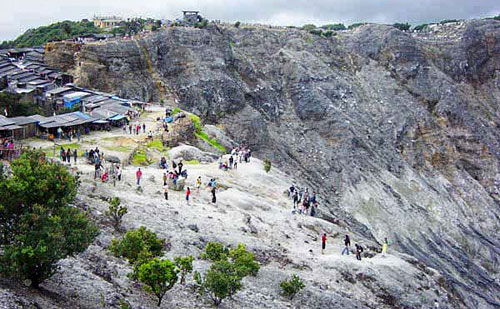 Tangkuban perahu is a volcano, 25 kilometers north of Bandung
direction of Lembang. Its location is in between Sagalaherang village,
Sagalaherang district, Subang regency and Cikole village, Lembang
district, Bandung regency. This is Bandung's most famous tourist volcano
just 28 km north of the city. This volcano offers many places to see
and explore. Whether we look into the huge crater or hike down into it,
stroll through the forest on its slopes, or simply enjoy the splendid
panoramic scenery. Mt. Tangkuban Perahu is an interesting destination
that everyone in the Bandung area is fond of visiting. When seen from
Bandung, Mt. Tangkuban Perahu has a distinctive shape, like an upside
down boat. Tangkuban Perahu means, in fact, "up-turned boat" This
peculiar shape has stimulated the fantasy of the Sundanese people from
early times as expressed in the Legend of Sangkuriang. Geologically, Mt.
Tangkuban Perahu has played a significant role in the development of
Parahyangan highlands. Eruptions have contributed immensely to the hills
north of Bandung through lava flowing into the valleys and hardening
into rock, thus forming big cliffs over which waterfalls leap. Likewise,
mud flows have formed a semi-circular cone of gentle gradient (what
geologists call "a fan"), which is now a mass that blocked the valley of
the ancient Citarum River near present day in Padalarang (some 18 km
west of Bandung), this caused a lake to form covering the whole Bandung
plain.
Tangkuban perahu is a volcano, 25 kilometers north of Bandung
direction of Lembang. Its location is in between Sagalaherang village,
Sagalaherang district, Subang regency and Cikole village, Lembang
district, Bandung regency. This is Bandung's most famous tourist volcano
just 28 km north of the city. This volcano offers many places to see
and explore. Whether we look into the huge crater or hike down into it,
stroll through the forest on its slopes, or simply enjoy the splendid
panoramic scenery. Mt. Tangkuban Perahu is an interesting destination
that everyone in the Bandung area is fond of visiting. When seen from
Bandung, Mt. Tangkuban Perahu has a distinctive shape, like an upside
down boat. Tangkuban Perahu means, in fact, "up-turned boat" This
peculiar shape has stimulated the fantasy of the Sundanese people from
early times as expressed in the Legend of Sangkuriang. Geologically, Mt.
Tangkuban Perahu has played a significant role in the development of
Parahyangan highlands. Eruptions have contributed immensely to the hills
north of Bandung through lava flowing into the valleys and hardening
into rock, thus forming big cliffs over which waterfalls leap. Likewise,
mud flows have formed a semi-circular cone of gentle gradient (what
geologists call "a fan"), which is now a mass that blocked the valley of
the ancient Citarum River near present day in Padalarang (some 18 km
west of Bandung), this caused a lake to form covering the whole Bandung
plain.Tangkuban Perahu is a volcano with three craters into which areas tourists can walk through. These three craters are: Kawah Ratu ("Queen Crater"), Kawah Domas ("Domas Crater"), and Kawah Upas ("Upas Crater"). Tourists can go down into the Domas Crater where exist many hot geysers in which they can boil eggs. Though the mountain appears peaceful, mild eruptions occurred in 1969, when Kawah Ratu spewed ash and barrages 500 m high. As recently as September 1992 it was closed to the public for a few days because unusually high seismic activity leads volcanologist to fear a new eruption. On the mountain's northern flank is an area called Death Valley, so named for its frequent accumulation of poisonous gases. On a reasonably clear day, from Kawah Ratu, the main crater, we can see not only the mountain range to the east, with Mt. Bukittunggul as its highest peak (2,209 m), but also two other in a northeasterly direction. The lower and nearer one is Mt. Tampomas (1,684 m) just north of Sumedang some 40 km away. To the right and about 90 km away is Mt. Ciremai close to Cirebon on the north coast. At 3,078 m, Mt. Ciremai is West Java's tallest mountain. At the foot of Mt. Tangkuban Perahu we see the Ciater tea plantation covering the rolling hills. Farther to the left are the northern coastal plains of Java, and on an extremely clear day we may even be able to see the Java Sea beyond.
Kawah Ratu, which means "Queen's Crater", is today just a big gray hole, which sometimes has a pool of water at its center. Poisonous gases sometimes accumulate in Kawah Ratu, thus making it somewhat of a risk to descend to the crater floor. Beyond the saddled shaped depression on the far side of Kawah Ratu is the still active Kawah Upas, the oldest crater on the mountain. On the very far western cliff we see a spot where all vegetation has been destroyed by constantly rising sulfurous vapors. On the crater walls, note the various layers of material consisting of rock, sand, and pebbles. Overtime, new craters have formed again and again in a rather consistent shift from west to east. The most well known of these is the Domas crater, but also there are other smaller ones in jungle on the mountain's northeastern flank. Facilities in Tangkuban Perahu Crater are comfortable parking area, souvenir kiosks, and restaurants.
Pangandaran Beach
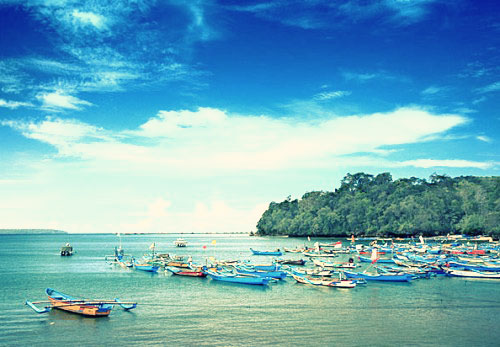 Small mainland peninsula with a national park with beaches and
stunning scenery to rival the beaches of Bali on the south coast of
Java. Pangandaran is one of Java's best-kept secrets as far as
international tourists are concerned, but has been extremely popular
with locals for along, long time. A small fishing town, it possesses one
of Java's finest beaches and Pangandaran Nature Reserve teems with wild
buffalo, barking deer and monkeys. The people are very friendly, this
combined with the idealize surroundings make this a great place to spend
a few days relaxing island-style. Pangandaran is halfway between
Bandung and Yogya, about 5 hours by bus from Bandung and 8 hours from
Jakarta.
Small mainland peninsula with a national park with beaches and
stunning scenery to rival the beaches of Bali on the south coast of
Java. Pangandaran is one of Java's best-kept secrets as far as
international tourists are concerned, but has been extremely popular
with locals for along, long time. A small fishing town, it possesses one
of Java's finest beaches and Pangandaran Nature Reserve teems with wild
buffalo, barking deer and monkeys. The people are very friendly, this
combined with the idealize surroundings make this a great place to spend
a few days relaxing island-style. Pangandaran is halfway between
Bandung and Yogya, about 5 hours by bus from Bandung and 8 hours from
Jakarta.This is the second beach resort area on the Indian Ocean after Pelabuhan Ratu. The site is 223 from Bandung and 400km from Jakarta. The trip by car or bus is recommendable because the road conditions are good. However, if we prefer to take the train, get into Bandung-Yogyakarta Express train and get off at the Banjar railroad station about 4 hours later. From here it will be another 50 km by bus to Pangandaran. The beach is called Penanjung, where most of the cottages and hotels are located, however, of modest ratings. Nothing luxurious should be expected. Pangandaran is especially of interest to nature lovers, as there is a wildlife reserve in the vicinity where wild birds and other indigenous animals live about freely to be enjoyed by visitors. In Pangandaran visitors will like fine white beaches, blue ocean and fine seafood. Twelve kilometers before arriving at Pangandaran visitors will see a huge rock on the beach, which is called Karang Nini.
Another place of special interest for nature lovers is a forest Conservation Park, close to the camping ground, which has basic facilities suitable for the younger set. Somewhat further out, west of Pangandaran, driving 23 km on the way to Parigi, lays Batu Hiu, meaning Shark's Rock, a coastal rock that has the shark shape.
Ciater Hot spring
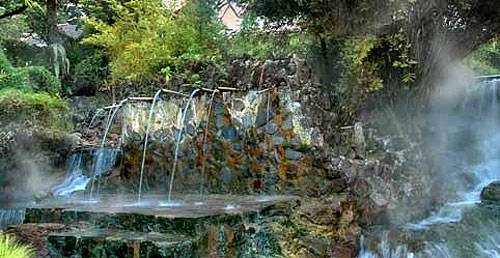 Ciater Hot Spring is a nice park with small pools in which we
can sit or swim. The streams and pools are fed by warm mineral springs,
which are created by the heat from nearby volcanoes. About 30 minutes
from Tangkuban Perahu crater. Ciater is pretty little place in the
middle of huge tea estate. Its main attraction is the Sari Ater Hot
Spring Resort; the pools are probably the best of all the hot springs
around Bandung. We can enjoy swimming in warm sulfurous water pools that
can heal rheumatism and skin problems. Here we can swim in warm mineral
water pools, good for healing skin problems. Ciater hot spring is one
stop place for entertainment and relaxation. Ciater is located in
Lembang, a green, lush place. The water contains iodium and sulfur, well
for curing skin ailments and rheumatism. Equipped with tennis courts,
restaurants, and camping area, Ciater is a good way to retreat from
every day's life.
Ciater Hot Spring is a nice park with small pools in which we
can sit or swim. The streams and pools are fed by warm mineral springs,
which are created by the heat from nearby volcanoes. About 30 minutes
from Tangkuban Perahu crater. Ciater is pretty little place in the
middle of huge tea estate. Its main attraction is the Sari Ater Hot
Spring Resort; the pools are probably the best of all the hot springs
around Bandung. We can enjoy swimming in warm sulfurous water pools that
can heal rheumatism and skin problems. Here we can swim in warm mineral
water pools, good for healing skin problems. Ciater hot spring is one
stop place for entertainment and relaxation. Ciater is located in
Lembang, a green, lush place. The water contains iodium and sulfur, well
for curing skin ailments and rheumatism. Equipped with tennis courts,
restaurants, and camping area, Ciater is a good way to retreat from
every day's life.Ciater is another area with tea plantations and hot springs, eight km northeast of Tangkuban Perahu. The place also has a tea factory. Ciater is a good starting point for hiking, and has some accommodation.
Mount Ratuha and Kawah Putih
 Mt Patuhu is located southwest of Bandung, Kawah Putih is a lake
on this mountains is sometimes pale turquoise, or as it's name says
white. The direction is drive to Ciwidey. Kawah Putih can easy be
reached by car all the way to the rim and then it is a 100 metre walk to
the lake it self. It is a very nice colorful lake. Far to the south of
Bandung, the hill becomes greener. The fresh air flows through the
bamboo trees marching along the way. Kawah Putih, The White Crater, is
waiting for who want to contemplate there.
Mt Patuhu is located southwest of Bandung, Kawah Putih is a lake
on this mountains is sometimes pale turquoise, or as it's name says
white. The direction is drive to Ciwidey. Kawah Putih can easy be
reached by car all the way to the rim and then it is a 100 metre walk to
the lake it self. It is a very nice colorful lake. Far to the south of
Bandung, the hill becomes greener. The fresh air flows through the
bamboo trees marching along the way. Kawah Putih, The White Crater, is
waiting for who want to contemplate there.Two craters adorn the summit of Patuha Volcano. The dry crater of Kawah Patuha lies 600 meters northwest of Kawah Putih, a crater lake with approximately 8 meters of water depth. Kawah Putih Crater Lake represents a relatively stable volcanic system, with no records of magmatic or phreatic activity since A.D. 1600. Surrounded by the tea plantation, Kawah Putih is a very prospectors tourist's destination in West Java - Indonesia. Located at about 30 km to the south of Bandung, Kawah putih is relatively easy to be reached. But, driving bu your own car is recommended, it's convenience because along the way, you can stop by to just take a rest, or buy strawberry, which can be easily found in this area. Fresh and considerably cheap.
Cimanggu Hot Springs
 Ciwidey is rich with hot springs. One of them has used by
Perhutani (State Forest Management Firm) as the source of Cimanggu
swimming pool. Cimanggu Hot Spring is some swimming pools full of hot
water from the mountain. The water is much hotter then in Hot Spring
Ciater Resort, the area of this hot spring is very nice and a good place
to relax. This hot spring is not so crowded as Ciater Hot Spring. The
drive from Bandung takes about 2 hours. It is a lovely spot reasonably
maintained, to relax, to swim, or just soak. The hot springs are
channeled into a small pool for children and a large hot water pool.
Cimanggu tourism site has some facilities such as; big parking area,
play ground, hot water swimming pool, public toilet and bathroom,
musholla, and drinking and food shops.
Ciwidey is rich with hot springs. One of them has used by
Perhutani (State Forest Management Firm) as the source of Cimanggu
swimming pool. Cimanggu Hot Spring is some swimming pools full of hot
water from the mountain. The water is much hotter then in Hot Spring
Ciater Resort, the area of this hot spring is very nice and a good place
to relax. This hot spring is not so crowded as Ciater Hot Spring. The
drive from Bandung takes about 2 hours. It is a lovely spot reasonably
maintained, to relax, to swim, or just soak. The hot springs are
channeled into a small pool for children and a large hot water pool.
Cimanggu tourism site has some facilities such as; big parking area,
play ground, hot water swimming pool, public toilet and bathroom,
musholla, and drinking and food shops.Batu-Tulis Ciaruteun (Stone Inscription)
 One of the oldest kingdoms of Indonesia, the Hinduism
Tarumanagara from the 5th century, was probably located near Bogor. In
the area a number of inscriptions has been found, under them a
remarkable one, which still can be seen in Ciampea, 15 km west of the
city, approximately two kilometers Southwest of the botanical gardens
It's a big stone in a riverbank, which contains several lines of Indian
style inscriptions, and two king-size footprints, which should have been
from the conqueror and king Purnawarman. This inscription tells about
the influence of king Surawisesa of Pajajaran in 1533, an important
Hindu-king. This inscription is used Sanskrit language.
One of the oldest kingdoms of Indonesia, the Hinduism
Tarumanagara from the 5th century, was probably located near Bogor. In
the area a number of inscriptions has been found, under them a
remarkable one, which still can be seen in Ciampea, 15 km west of the
city, approximately two kilometers Southwest of the botanical gardens
It's a big stone in a riverbank, which contains several lines of Indian
style inscriptions, and two king-size footprints, which should have been
from the conqueror and king Purnawarman. This inscription tells about
the influence of king Surawisesa of Pajajaran in 1533, an important
Hindu-king. This inscription is used Sanskrit language.A replica of the stone can be found in the Fatahillah Museum in Jakarta. The name of the kingdom seems to have close ties with the river, which runs through the Bandung Basin east of Bogor to the coast, Citarum River. Because the inscriptions were found here, the historians concluded the capital of Tarumanagara should have been here, also because it's a good place for defense, and it also provides entry to the fertile hinterlands and the nearby trading harbors at the Sunda Strait.
The site is located on the bank of the Ciaruteun river in Ciampea village which can be reached by driving along the 9-kilometer road from Bogor to Ciampea followed by going on foot for about two kilometers.
Puncak
 Between Bandung and Bogor in the mountains lays Puncak, a cool
area, which is very popular. People from Jakarta spend their weekend and
on public holidays from the heat and busy streets of the capitol of
Indonesia to Puncak. Bandung to Puncak takes about 3 hours drive. Puncak
Pass area has long been the foremost weekend retreat for Indonesians
capital city residents. The cool, fresh air, and the magnificent view
offer a calm, fresh and peaceful feeling. In the afternoon, sunsets from
the top of the pass can be quite spectacular.
Between Bandung and Bogor in the mountains lays Puncak, a cool
area, which is very popular. People from Jakarta spend their weekend and
on public holidays from the heat and busy streets of the capitol of
Indonesia to Puncak. Bandung to Puncak takes about 3 hours drive. Puncak
Pass area has long been the foremost weekend retreat for Indonesians
capital city residents. The cool, fresh air, and the magnificent view
offer a calm, fresh and peaceful feeling. In the afternoon, sunsets from
the top of the pass can be quite spectacular.Puncak Pass is one of interesting destination in the West Java Province. It is located in the south of Jakarta and can be reached by an hour journey. Puncak is an ideal place for weekend, as well as a good location to find a fresh mountain air. Besides, many attractions can be found nearby, such as the Bogor and Cobodas Botanical Gardens; the Gede Pangrango National Park; the Plantations and the Safari Park.
Puncak Indah consists of three districts: Ciawi, Megamendung, Cisarua. The area is familiar with its fresh air and beautiful panorama. From Ciawi to Cipanas, there are many bungalows, hotels, motels, restaurants, and other tourism facilities. Tourisms object in Puncak is Lido Park, which is located in Cigombong village/Wates Jaya (km. 21) Rd. Ciawi-Sukabumi, Cijeruk. Facilities that are provided in Lido Park ara restaurant, cottages, swimming pools, camping grounds, and other facilities for lake recreations. Gunung Mas XII Plantation, which is located in Rd. Puncak, Cisarua district. It offers panorama with hilly panorama, which could only be found in Puncak. Activities that could be done are tea walk and seeing the making of the tea from the picking of tea until the tea is ready to serve.
Taman Safari
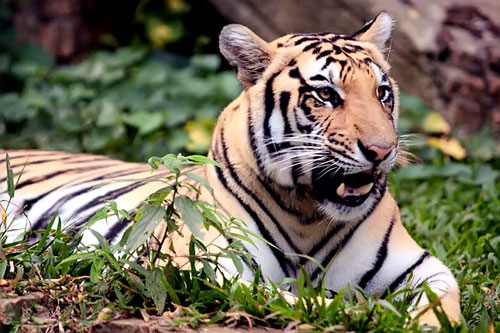 The wildlife conservation is located in Cibeureum village,
Cisarua. Taman Safari Foundation owns the land in Taman Safari, which is
also the management of the tourism object. Facilities in Taman Safari
are bus, artificial lake, water cycling, canoe, swimming pool, mini
train to see African style village, Bird Park, go cart, children
playground, windmill, circus, merry-go-round etc.
The wildlife conservation is located in Cibeureum village,
Cisarua. Taman Safari Foundation owns the land in Taman Safari, which is
also the management of the tourism object. Facilities in Taman Safari
are bus, artificial lake, water cycling, canoe, swimming pool, mini
train to see African style village, Bird Park, go cart, children
playground, windmill, circus, merry-go-round etc.Animals from all continents roam freely in this 35-hectare park, 75-km southeast of Jakarta along the Jakarta-Bandung route. Among the animals kept here are some comparatively rare species such as anoas, rhinos, giraffes, white tigers and European, American and Asian bears. Adjacent to the park is recreational grounds with a swimming pool, tennis courts, an artificial lake, waterfall and children's playground and amusement park. There are also restaurants and cafeterias.
Taman safari is a drive through zoo and amusement park and is open every day. On the way from Bandung to Taman Safari we have to pass Puncak, do not try to do this on Sunday or public holiday because we can end up in a big traffic jam, because Puncak is a very popular spot for people from Jakarta. Normally, it take 3,5 hours from Bandung to get to Taman Safari.
Cangkuang Temple
 Cangkuang Temple is 10 kilometers from Tarogong to the North in
the direction to Bandung. To go there, tourists particularly foreigners
took delman (a traditional land transportation with horse in the front).
Beautiful flowers cover the shallow situ. There is a small island in
the middle of the lake, namely Cangkuang temple. It is the only Hindu
temple that ever found in West Java is the important discovery in the
past. Cangkuang has been built in the period of the first Sundanese
Kingdom: Galuh Kingdom. Near the temple, there are heritage graves from
the Moslem follower Arif Muhammad, who is one of the Mataram Kingdom
soldier from Central Java when attacking the Dutch Colonialist in
Batavia (now Jakarta), at the 17th Century. The ambush failed, he
refused to return and stayed in Cangkuang for teaching and disseminating
Islam to the surrounding community, precisely in Kampung Pulo, where
his hereditary stays until now. In Kampung Pulo, can be found the
traditional village, which contains six houses in a row and
face-to-face, three on the left and three on the right, plus one mosque,
which stays only six families. In the edge of the lake, to reach
Cangkuang temple, people must use traditional transportation made from
bamboo, but safe and comfortable that is called rakit (raft).
Cangkuang Temple is 10 kilometers from Tarogong to the North in
the direction to Bandung. To go there, tourists particularly foreigners
took delman (a traditional land transportation with horse in the front).
Beautiful flowers cover the shallow situ. There is a small island in
the middle of the lake, namely Cangkuang temple. It is the only Hindu
temple that ever found in West Java is the important discovery in the
past. Cangkuang has been built in the period of the first Sundanese
Kingdom: Galuh Kingdom. Near the temple, there are heritage graves from
the Moslem follower Arif Muhammad, who is one of the Mataram Kingdom
soldier from Central Java when attacking the Dutch Colonialist in
Batavia (now Jakarta), at the 17th Century. The ambush failed, he
refused to return and stayed in Cangkuang for teaching and disseminating
Islam to the surrounding community, precisely in Kampung Pulo, where
his hereditary stays until now. In Kampung Pulo, can be found the
traditional village, which contains six houses in a row and
face-to-face, three on the left and three on the right, plus one mosque,
which stays only six families. In the edge of the lake, to reach
Cangkuang temple, people must use traditional transportation made from
bamboo, but safe and comfortable that is called rakit (raft).Telaga Bodas Crater
 It is a very nice and beautiful place for hiking and to know the
nature from close range (natural studies). The crater is very
captivating with water in the crater, which becomes the sulfur
exploitation project. Tourists that intend mostly visit the tourism site
to bath in the hot water, which contains sulfur. The surrounding view
is beautiful, which is full of plants and tropical trees. Telaga Bodas
Crater is situated 19.5 kilometers from Garut. Some 30 kilometers from
Garut to the Southwest, there is Curug Orok tourism site. The tourism
site is beautiful waterfall as the road to reach Curug passes tea
plantation. Natural scene in the Curug surrounding areas and the
atmosphere of mountainous areas with green tea plantations are the
magnetic charms of the tourism site. No wonder many youngsters love to
visit the site. Other activities that could be done in the site is
bathing in the waterfall. It is good for tourists that seek peace or
take a rest for a while from busy cities atmosphere. To reach the site,
private cars and public transportation from Garut to Bungbulang could be
used.
It is a very nice and beautiful place for hiking and to know the
nature from close range (natural studies). The crater is very
captivating with water in the crater, which becomes the sulfur
exploitation project. Tourists that intend mostly visit the tourism site
to bath in the hot water, which contains sulfur. The surrounding view
is beautiful, which is full of plants and tropical trees. Telaga Bodas
Crater is situated 19.5 kilometers from Garut. Some 30 kilometers from
Garut to the Southwest, there is Curug Orok tourism site. The tourism
site is beautiful waterfall as the road to reach Curug passes tea
plantation. Natural scene in the Curug surrounding areas and the
atmosphere of mountainous areas with green tea plantations are the
magnetic charms of the tourism site. No wonder many youngsters love to
visit the site. Other activities that could be done in the site is
bathing in the waterfall. It is good for tourists that seek peace or
take a rest for a while from busy cities atmosphere. To reach the site,
private cars and public transportation from Garut to Bungbulang could be
used.
Tidak ada komentar:
Posting Komentar